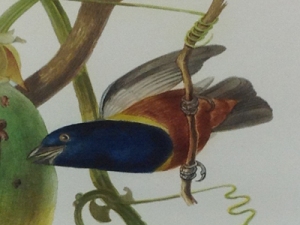Original Information on Plate
- Jean-Théodore Descourtilz
- 1852-1856
- 33 Euphonia Galoti
- Ink on Paper
- L2010.85.86
- W. Graham Arader III, Arader Galleries
Bird and Plant Identification
In Plate 33 the four birds are the Blue-naped Chlorophonia (Chlorophonia cyanea) located on the top, the Chestnut-bellied Euphonia (Euphonia pectoralis) located in the middle-right, the Golden-rumped Euphonia (Euphonia cyanocephala) located in the middle-left, and the Violaceous Euphonia (Euphonia violacea) located on the bottom. E. pectoralis, E. cyanocephala, and E. violacea are all found in the genus Euphonia and the family Fringillidae. C. cyanea is also found in the family Fringilidae but in the genus Chlorophonia. Originally, Descourtilz labeled all the birds depicted in the plate under the genus, Euphonia. This may be due to the fact that Chlorophonia and Euphonia were considered historically similar, although the Chlorophonia is visibly much greener. Also, E. pectoralis was originally labeled E. galoti, however, there is no documentation or record of E. galoti.
The plant visible in the plate is the Passiflora edulis, also commonly known as the passion fruit. It is in the family Passifloraceae. Passion fruit is an evergreen, perennially flowering vine that grows as it spiraling its tendrils around a sturdy structure. It is native to southern Brazil into Paraguay, and northern Argentina.
Ecological Inconsistencies: Range
E. violacea has the most extensive range of the birds present on L2010.85.86 extending from mid to eastern Venezuela, the Guianas, and much of mid to eastern Brazil. E. violacea overlaps with the other birds only in the southernmost points of the range of E. pectoralis in the Brazilian Highlands. E. cyanocephala and C. chlorophonia overlap ranges with both E. violacea and E. pectroralis in the Brazilian Highlands. However, the ranges of E. cyanocephala and C. chlorophonia also extend along the east of the Andes Mountains overlapping from central Bolivia up through Venezuela.
Ecological Inconsistencies: Habitat
Although the ranges of the birds of Plate L2010.85.86 overlap in the southeastern area of Brazil, the habitats vary some among the four species. E. violacea, E. pectroralis, and C. cyanea are found in humid forests and in clearings with tall, scattered trees. All four birds are found in forest borders. E. violacea and E. cyanocephala are also found in second growth forests whereas E. cyanocephala is typically not found inside the forest. Also notable is C. cyanea is found in lowlands and at sea level, E. pectoralis is found from sea level to 1550m, and E. cyanocephala is found mainly in lowland and montane elevations.
Ecological Inconsistencies: Food
E. violacea and E. pectoralis feed on fruits and nectar. E. cyanocephala and C. cyanea feed mainly on fruits but also on some insects.
Ecological Inconsistencies: Plant Species
The species of birds depicted in the drawing are not likely to consume passion fruit without another species creating the aperture. However, they will likely eat the passion fruit opportunistically if the option presents itself.










